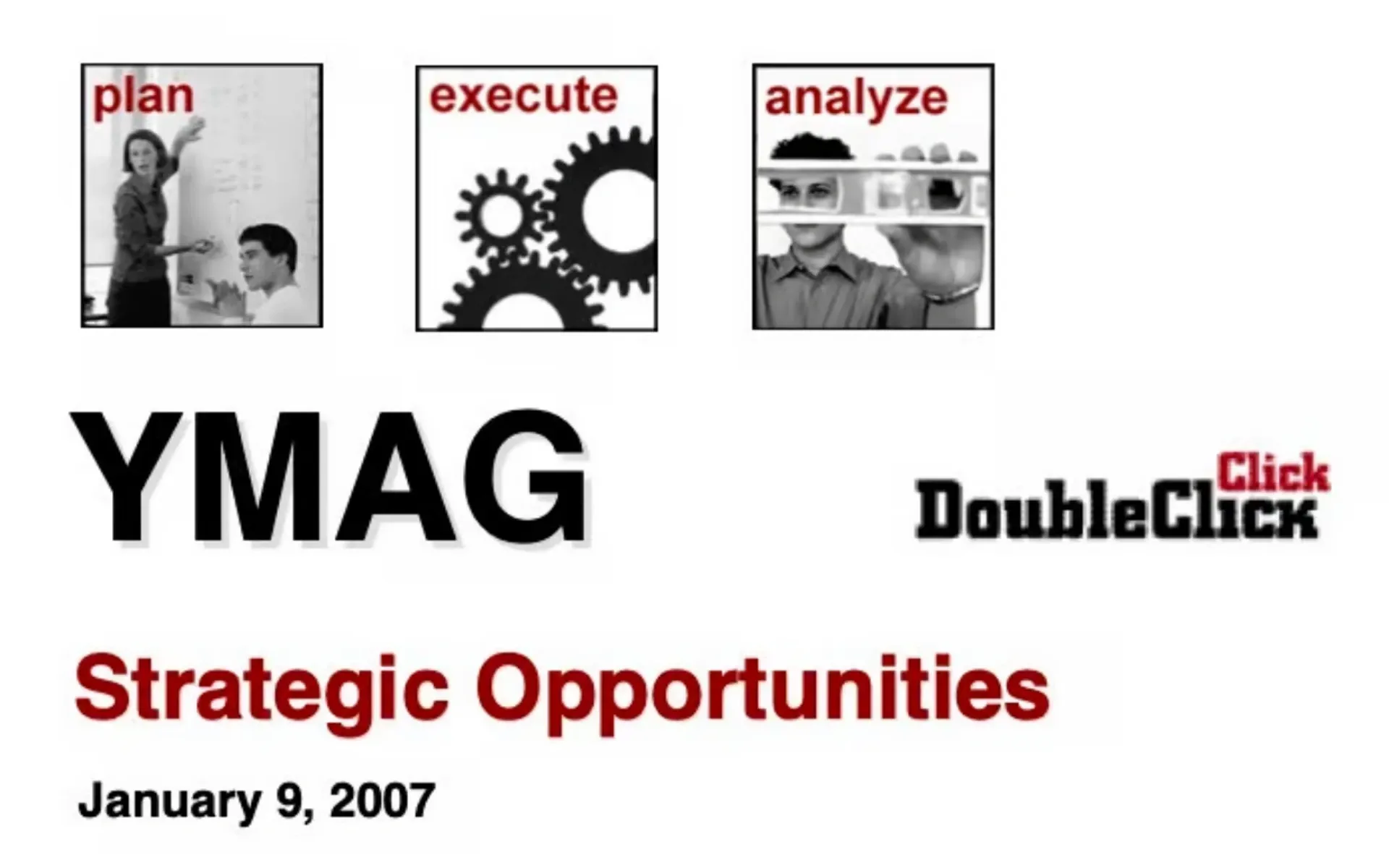DoubleClick's 2007 Sales Pitch to Google revealed: a $2.8 Billion opportunity
Newly uncovered deck shows DoubleClick's strategic vision for ad tech dominance, predicting massive revenue potential for buyers.

In a surprising revelation on September 4, 2024, Ari Paparo, a prominent figure in the ad tech industry, disclosed the previously confidential sales deck used by DoubleClick to pitch its acquisition to Google in 2007. This document, known as the YMAG (Yahoo Monetization of Available Google inventory) presentation, provides unprecedented insight into the strategic thinking behind one of the most consequential deals in digital advertising history.
According to the leaked deck, DoubleClick positioned itself as a dominant force in the advertising technology landscape, boasting relationships with "9 out of 10 agencies" and "9 out of 10 sites," including "35 out of Top 50 web publishers." This market penetration was a key selling point, demonstrating DoubleClick's potential to deliver significant value to its eventual acquirer.
The presentation, dated to the period preceding Google's $3.1 billion acquisition of DoubleClick in 2008, outlines a compelling vision for the future of digital advertising. At its core, the deck emphasizes the strategic importance of DoubleClick's sell-side technologies, particularly its ad serving platform DART for Publishers (DFP), which later evolved into Google Ad Manager (GAM).
One of the most striking aspects of the YMAG deck is its financial projections. DoubleClick estimated that the acquiring company could generate an additional $2.6 billion in annual revenue by leveraging DoubleClick's technology and publisher relationships. This projection was based on a complex model that factored in available ad impressions, potential CPM (cost per thousand impressions) increases, and the lift in monetization that could be achieved through various synergies.
The deck breaks down this revenue opportunity as follows:
- DFP Tier 1 publishers: 1.8 billion impressions per month, with a projected $6 CPM and a 150% lift, resulting in $15 million per day.
- DFP Tier 2 publishers: 3.3 billion impressions per month, with a projected $0.50 CPM and a 300% lift, resulting in $4.8 million per day.
These daily figures, when annualized, account for the bulk of the $2.6 billion projected incremental revenue.
A key technology highlighted in the deck is "Dynamic Allocation," which DoubleClick touted as a unique value proposition. This feature allowed real-time competition between direct-sold ads and those from the ad exchange, ensuring that publishers could always select the highest-yielding demand source for each impression.
The YMAG presentation also sheds light on the nascent state of DoubleClick's ad exchange, then called "DoubleClick Marketplace." In 2007, the exchange was projected to generate only $800,000 in revenue. However, the deck positions this technology as a crucial component of future growth, emphasizing its potential to create a "largest pool of liquidity" in the digital advertising market.
Interestingly, the deck pays relatively little attention to DoubleClick's buy-side technologies, such as DART for Advertisers (DFA). This aspect of the business was presented as somewhat speculative, with potential opportunities in retargeting and data-driven buying. In retrospect, this area has grown significantly, with Google's demand-side platform (DSP) now known as DV360 reportedly generating over $10 billion in revenue.
The YMAG deck also provides insight into the competitive landscape of the time. It references "the Big Four" - Yahoo, Microsoft, AOL, and Google - as the primary contenders in the digital advertising space. The presentation suggests a sense of urgency, stating that "the race to the finish line is on," implying that the acquisition of DoubleClick could be a decisive factor in determining market leadership.
From an antitrust perspective, the deck's contents may prove significant. It clearly outlines the potential for creating a reinforcing loop of advantages by combining Google's search advertising demand with DoubleClick's dominant position in publisher ad serving. This strategy, which came to fruition in the years following the acquisition, has been a focal point of recent antitrust scrutiny directed at Google's ad tech business.
Key facts from the YMAG deck
- DoubleClick claimed relationships with 90% of top agencies and publishers in 2007
- The company projected $2.6 billion in annual incremental revenue for the acquirer
- DoubleClick's ad exchange was expected to generate only $800,000 in 2007
- The deck emphasized the strategic importance of the "Dynamic Allocation" feature
- Buy-side technologies were given less prominence in the pitch
- The presentation identified Yahoo, Microsoft, AOL, and Google as the main competitors
- DoubleClick's publisher ad server handled approximately 19 billion impressions per month
- The deck suggested that being the "primary ad server" would provide a crucial "first look" advantage

